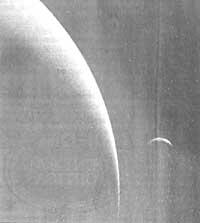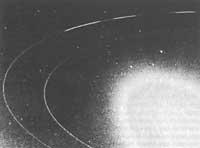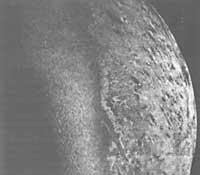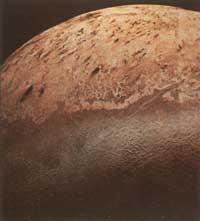Neptune: Last Voyager 2 Scale
1990/05/01 Arregi Bengoa, Jesus Iturria: Elhuyar aldizkaria
The first analysis of the vast amount of information sent by Voyager 2 in August as it passes through the Neptune environment has already been published in specialized journals. In this issue we will mention the most relevant results offered by these studies on Neptune, and in the next issue we will talk about his satellite Trinon.

Next August 20 will be the thirteenth year of launch of Voyager 1 and 2, and last February Voyager 2 (which was only used in the examinations until Saturn) made the first photos of the entire Solar System, that is, the first in which the Sun appears surrounded by its planets. Needless to say, therefore, that this probe has been a success. More if we take into account that the benefits offered in the last stages of the trip have been better than those offered when it was launched. This improvement has been achieved, logically, with the reprogramming of the existing computer. Neptune, the last scale of Voyager 2, has been more interesting than expected, revealing some of the unforeseen that have surprised scientists.
Let's start by providing some physical data of the planet and its orbit (Table I) and explaining its photographic aspect. From the table data it follows that the diameter of Neptune is approximately four times larger than that of Earth. On the other hand, it is the densest of the giant planets. In the photos appears Neptune blue remembering the appearance of the Earth seen from space. The dispersion or dispersion of sunlight caused by the atmosphere of Neptune (the same phenomenon gives the blue color to the earth sky) and the second and main, the behavior of methane in the atmosphere.
Average distance from theSun Translation
period
Revolution period Equatorial diameter Average density
4.496.6 million km 164.8 years
16 hours 3 min.
49.500 km
1,64 g/cm3
Methane absorbs red light, leading to the predominance of blue light. However, the amount of methane in Neptune is very small, with its main components being hydrogen and helium. The temperature of the exposed outer layers can be estimated at around -220°C. However, one of the unexpected has been the activity detected in these layers.

All fluctuations in Earth's climate and atmospheric activity are due to energy coming from the Sun. Due to the remoteness of Neptune with the Sun, irradiation is 1000 times lower than on Earth (or 20 times lower than on Jupiter). Therefore, it was expected to find its dead atmosphere. On the contrary, Voyager 2 has found very strong winds and some spots, two dark and
some luminous. In the first two stands the so-called “Great Dark Spot”.It has a length of 12,000 km and a width of 8,000 km and its relative measures with Neptune are similar to those of Jupiter in its “Great Reddish” with respect to this planet, as well as its location. The aforementioned Great Tan changes its appearance with relative speed and the speed of movement is also high, with 325 m/s to the west. Next to this bite, and moving with it, we have one of the clearest moments mentioned, the S1. This, as we have said, is related to the above, in the south, and it seems to be what was seen from Earth a few years ago. It is believed to consist of methane clouds that condense at high altitudes (50 km). Condensation, when the wind of the higher layers of hydrogen that cover the Neptune finds an obstacle (in this case the Gran Moreno), would occur cooling the methane that rises and drags.
Further south we have another bright moment, the S2. The particularity is its speed: It only takes 16 hours to surround Neptune. Therefore, it is also known as Scooter. But their evolution is not the only problem that these phenomena present. As we have said before, the mere energy contribution of the Sun can hardly generate so much activity. Where then is the necessary energy produced? Perhaps Neptune himself has a small source of energy.
SUN: On MOON:
|
Magnetic field measurements have also obtained surprising results. Voyager 2's magnetometer has shown that the magnetic field axis is tilted about 50 degrees above the planet's axis of rotation and does not pass through the center of the planet, but about 8,000 km from the center. These particularities of the magnetic field are similar to those of the Uranus field and do not facilitate its explanation. On the contrary, when the inclination of the magnetic axis of Uranus was measured, the scientists proposed whether there was any investment or investment similar to that of the Earth in this field, but the probability of finding Neptune in the same process would be infinitesimal.

Therefore, it seems that if a good explanation is to be found, it will be one of those related to the nature of these planets. The results of the study of the magnetic field are also of great importance, since they provide us with the only information that we can obtain on the internal structure of the planet. Thus, the rotation period of the magnetic field (16 hours and 3 minutes) provides the only reference for the calculation of the velocities relative to the inner core of the outer layers.
However, among the forecasts made there is at least one that has been completely fulfilled; the corresponding to the discovery of new satellites. Observations made from Earth only confirmed the existence of two satellites: Triton, the largest, and Nereida. Now we know that they are eight. One of them has a diameter greater than that of Nereida, but its great difference has prevented its detection from Earth.
Like other giant planets, Neptune has its ring system. Observations made from Earth in 1984-85 reveal the existence of annular arches. Now that it has been proven that the devices of the Voyager 2 are oriented to the right place, it has been proven that the rings are three and are complete. The three arches seen from the ground are abnormal accumulations of mates found in the farthest ring of Neptune. These arches pose a problem of difficult explanation, since, dispersing along the ring, they would have to disappear spontaneously as a result of the shocks. Some have wanted to find the reason in the satellite shepherds that were around the arch, but it seems that the full explanation of the problem is still far away.
The two outer rings are very thin, as they are only a few kilometers high. The interior is very diffuse and occupies 2,500 km wide. Although the previous two are formed by rocks and dust of different sizes, the interior is mostly formed by dust. Finally, between the two outer rings a much wider ring of fine dust has been observed, extremely diffuse compared to the previous ones.
Of course, the analysis of data sent by Voyager 2 will last for years. The work to solve all the aforementioned problems has only begun and will give great headaches.
|

Gai honi buruzko eduki gehiago
Elhuyarrek garatutako teknologia




